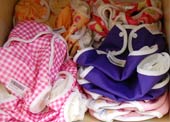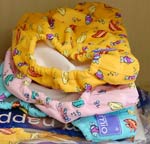The Very Best Nappies for Less Expense
Nappies for less?
If you want to get good, effective nappies for less expense, it's time to look at eco-friendly cloth nappy options!

cloth nappies can be colourful
|
Probably the best and most cost-effective nappies are shaped cloth nappies. Here are some reasons why cloth nappies may be both the most eco-friendly and pocket-friendly option - and why your baby may prefer them too.
Modern cloth nappies even come in fun colours and patterns (picture, right).
Sponsored links
Time was that if you wanted to use cloth nappies rather than disposables you would need to by a large stack of terry towelling squares, invest in a few large (sharp!) nappy pins and maybe buy a few simple liners and plastic wraps.
Other than a load of washing powder and plenty of determination, that was it!
Now it has become possible to use cloth nappies and get excellent nappies for less expense, knowing that your baby is not putting an undue strain on the earth's resources. Cloth nappies have moved on a whole dimension in the last twenty years. There is now a host of different products available and cloth nappies are becoming an ever-more practical alternative to disposables.
Nappies for less - the debate
The argument still rages about which type of nappy is the more environmentally friendly.
Obviously disposables contribute to landfill in a way which terrys clearly don't. (Disposables currently contribute around 4% of all landfill in the UK, with more than 8 million disposables being thrown away daily!) But they are also an environmental bane because most of them will take hundreds and even thousands of years to bio-degrade. Add to that the bleaches and harmful chemicals which go into their manufacture and the balance tips towards reusable and recyclable cloth nappies.
Nappies for less:
What are the environmental costs of cloth nappies?
In 2005 an influential report was produced by the UK Environment Agency which concluded that there was little difference between cloth and disposable nappies in their effects upon the environment. Many environmentalists and women's campaigning groups felt that it was a seriously misleading report.
However, as they pointed out in the report, the effects are actually very different. Disposables create pressure on landfill sites and generally they are not bio-degradable. Their manufacture involves many chemical processes. The bleaching of paper products for nappies contributes highly toxic dioxins and other nasties which then leach into water courses and disrupt wildlife.
The environmental hazards of using cloth nappies are almost entirely different. The main environmental load comes from the washing, drying and detergent used in cleaning. These hazards are far more under the control of the individuals using the products; detergents can be low phosphate ones - or even replaced by washballs; washing can be low temperature and drying can be mainly or partly air-drying inside or out. (Please see the laundry tips page for more on this.) Even the volume of water used can be limited by using modern high-efficiency machine washing.
By contrast, most of the hazards of using disposables are beyond our control, except in so far as we buy the modern low-impact eco-disposables now coming onto the market.
If you are interested in the issue of real nappies and the environmental costs of disposables you can learn more at The Real Nappy Information Service. There are some local groups promoting real nappies in the UK, too.
What's here?
This article gives an overview of cloth nappies and looks into why they are largely more environmentally friendly and sustainable than most disposable nappies.
There is a brief look at the different types available, which are the easiest and most environmentally friendly and a little info on the health benefits of real nappies.
There is also some info on how cloth nappies can save you money - nappies for less expense overall.
There are several types of cloth nappy which are popular.
Here are some of the many advantages of cloth nappies over their rivals
A well-chosen cloth nappy fits really snugly. The outer wrap gives an additional layer of protection. You should therefore experience fewer messy incidents where baby poo is not properly contained! With fewer leaks to cope with, you may even find that your total wash load goes down rather than up.
The use of a nappy liner gives some of the convenience and immediate disposability that standard disposables offer.
Nappies for less:
Reduced costs
The cost of real nappies is mainly upfront but once that's out of the way, you should save money by using cloth rather than disposables, especially if you have more than one child. This is a tricky area to judge because there is so much choice available and children vary in their needs. It's also impossible to compare like with like. If you upgrade your nappies with each child, then your total expenditure is bound to rise.
There's no doubt about it, the upfront cost of buying cloth nappies can be considerable. One way to do it is to buy your nappies in one go, from birth to toddler size. This can help reduce costs some because the manufacturers often do deals for multi-sized packs that should see you through the whole nappy wearing times.
Bulk buys
If you want to save by buying your cloth nappies in bulk, This deal from OsoCozy
looks like a good deal.
The main problem with buying in bulk is that you need to be quite sure that you are going to get along with your chosen product. It's good to check the reviews on Amazon or eBay to help with this and consult widely with friends and other mums.
Low temperature
It is possible to save money by using cloth nappies, especially if you use low temperature washes and air dry a lot of the time. Tumble driers are notorious for hiking the electricity bill! Most cloth nappy manufacturers recommend a 60 degree wash; you can reduce this still further for wet only nappies, especially if they are dried outside.

swim nappies are becoming popular
|
Many cloth nappies can also be re-sold when you have finished with them which helps diminish the costs further.
The Women's Environmental Network has estimated that washing nappies at home could save families around £500 per child.
Comfort for your baby
There's very little doubt that well-chosen cloth nappies are more comfortable than disposables - after all would you choose paper and plastic underwear? If you launder cloth effectively the material can be really soft and snugly - this helps it to fit well, too. With the more ergonomic modern designs cloth nappies really become very desirable for the comfort of your baby.
Nappies for less:
Convenience
Much is made of the convenience of disposables but cloth nappies can be quite good on this front, too. Many disposable liners can be just flushed down the loo so there's no pooey bin bags full of soiled nappies sitting around until dustbin day. The soiled nappies go into a bucket until a wash load is ready. These buckets invariably have air-tight lids, so any smell is contained. The contents can be immersed in a pre-wash solution which further reduces any smells. Essential oils can also be used.
You can buy special bags for carrying wet cloth nappies when you are out and about - perhaps less convenient than putting a disposable nappy in a rubbish bin, but perfectly practical. There's also a new device available which bags and seals wet nappies effortlessly.
There's also the option of hybrid or pouch nappies. These have all the convenience of disposables plus some of the advantages of cloth nappies. gDiapers manufacture a hybrid nappy which has inserts you can even compost. They have virtually no plastic in them, so they biodegrade effectively. The outer breathable pants fasten with secure Velcro around the back and the inner linings can be flushed if you don't like the idea of composting!
There are some health benefits to real nappies, too. For my money, probably the biggest on-going benefit is that you are not exposing your baby's skin to a cocktail of chemicals. Disposable nappies are produced in a highly chemical environment. There may be more problems associated with disposables for boy babies, too - see below.
When your baby is a newborn, using cloth nappies it can be easier to tell whether any urine has been passed. This is an important indicator that the infant is suckling properly and is getting properly hydrated and fed. It's re-assuring for mothers who are new to breast-feeding to see the evidence of their success! After the newborn period it is still useful to be able to at times monitor that your child is producing urine and stools normally. This can be easier with cloth nappies.
Modern cloth nappies are no longer the bulky ungainly affairs that previous generations had to manage with. Nevertheless, the added layers around sensitive areas can be of some benefit in protecting your baby when she starts to walk.
Many disposables make a big point of how much freer your baby will be to toddle and play but the fact is that many of them are so slim-line that there's not much left by way of protection for that precious derriere!
One concern with disposables is that they may affect male fertility. This is because the temperature in the scrotal area is raised by the non-breathable plastics and other materials found in disposables. This raised temperature can be enough to disrupt the normal development of the testes in baby boys, leading to fertility problems in adulthood. Male infertility is an increasing health concern in many countries. 1 in 6 couples in the UK experience difficulties conceiving and male infertility is thought to be to blame for around half that figure. Read more about this issue in this BBC article
Nappies for less:
Some health benefits
Sponsored links
Most authorities agree that toilet training tends to happen earlier with cloth nappies. The simple reason for this is that the child is more able to tell that he is wet as a direct and speedy consequence of passing urine. Locking away the fluid, as many disposables now do makes it harder for the child to notice the process and consequences. Cloth nappy-clad babies are toilet trained on average 6 months earlier than their disposable-clad peers.
So, of course, if you use cloth nappies you have 6 months of nappy costs which you don't probably won't need to pay. Not so much nappies for less - more like less nappies!
Nappies for less:
Earlier toilet training
Custom Search
The Best Nappies for Less Expense TOP
Greenfootsteps Home - for more easy green living ideas
The Very Best Nappies for Less Expense, copyright Greenfootsteps.com 2009
Please do not copy without permission.
| Tweet |

| Tweet |

Sponsored links
On other pages:
Footprints
- an occasional e-zine from Greenfootsteps
If you would like to receive the e-zine, please just sign up below.






New! Comments
Have your say about what you just read! Leave me a comment in the box below.